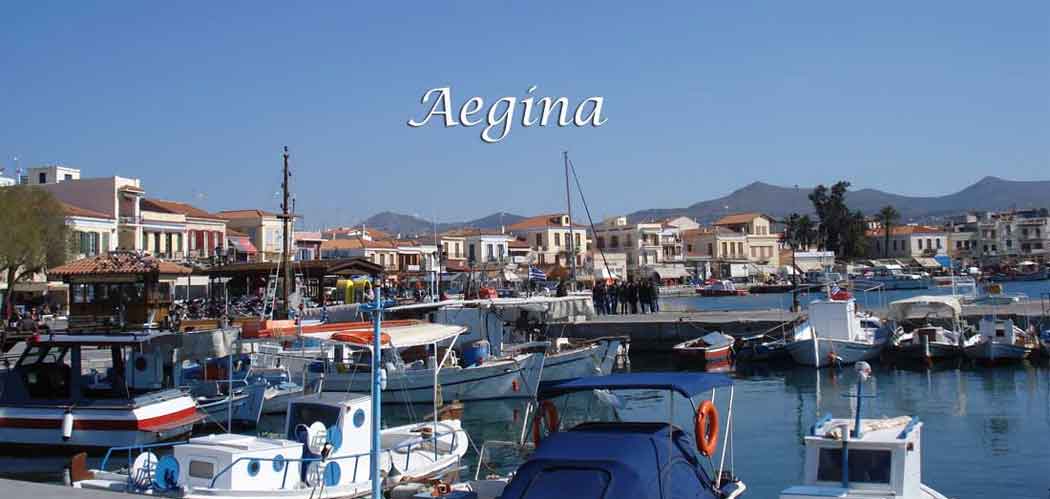Information about Aegina Greece
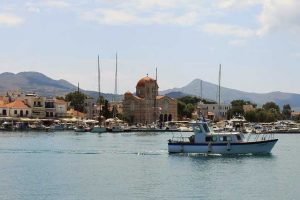
The people of Aegina have always been involved with the sea: either as fishermen, sailors or shipbuilders. Some are also farmers, and they grow olives, pistachio nuts and fruit.The town of Aegina has many attractions, a ride through the town with a horse carriage is a nice experience and a good way to enjoy the sights of the capital.
As picturesque as the promenade on the waterfront is, with the carriages, the neoclassical buildings, the floating greengrocers, the cafes and the taverns around the fish market, don’t just stop there. Look for the lesser-known among the many imposing public buildings of the Kapodistrian era, such as the Government House. The hinterland is rich in archaeological and religious attractions and beautiful landscapes.
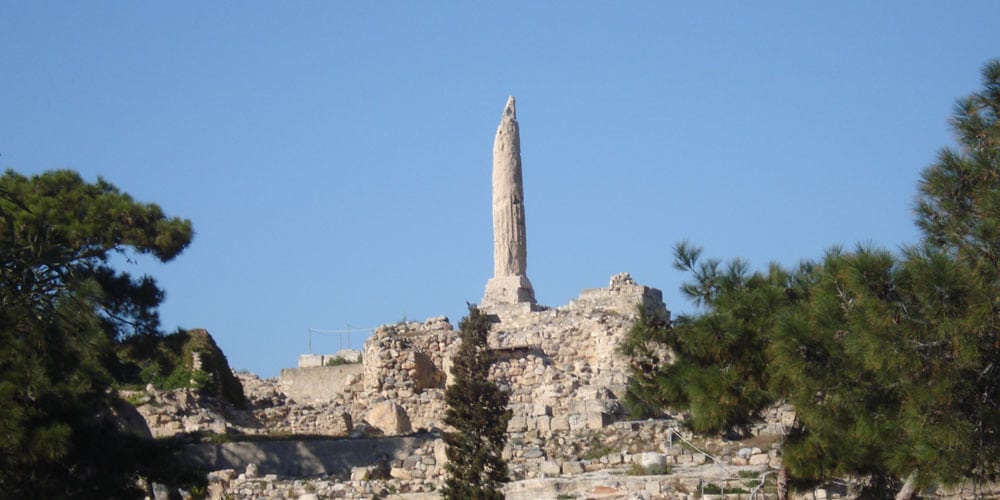
From the pine-lined route to the classic beach of Agia Marina to the more “Cycladic” route that connects the port with the village of Anitseo and Portes harbor with its fish taverns. If you stay more than one day, transportation is necessary to get around the island. Pedal fans take your bike with you or rent one, the island is suitable for cycling.
The island has an ancient history and for this reason several attractions of archaeological and historical interest. The beautiful natural environment, its tourist development and the very close distance of the island from Athens, make it an ideal destination for short and long escapes from everyday life throughout the year.
The buildings of the island are examples of Neoclassical architecture with a strong folk element, built in the 19th century, they remain there as a reminder that Aegina was the capital of Greece for 2 years.
Within the town of Aegina, but also inland, you will find many interesting sights, which are worth visiting. In Aegina you will find cosmopolitan organized beaches, excellent local and international cuisine, pine forests that reach the sea and a wide variety of options when it comes to your nightlife..
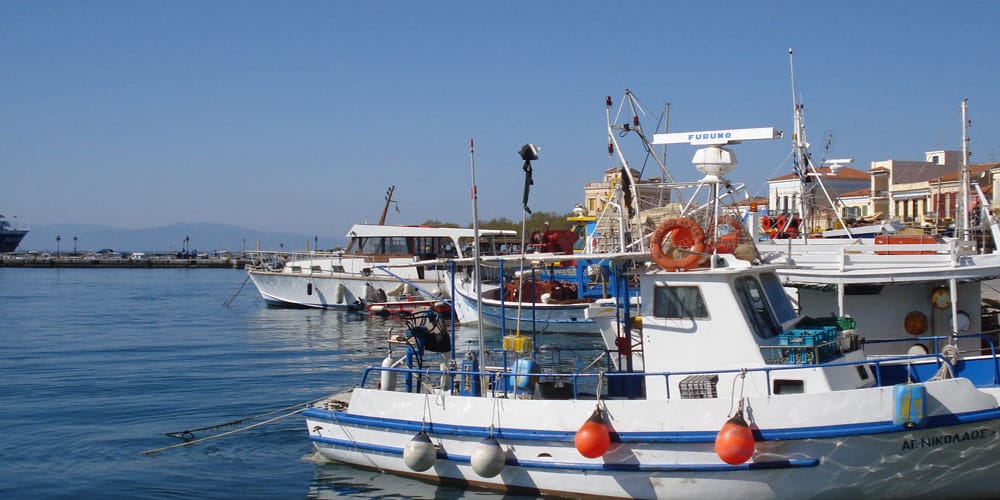
The city of Aegina is the homonymous capital of the island and is located on its western side, built amphitheatrically towards the sea. At the entrance of the port, the small white church of Agios Nikolaos of Thalassinos welcomes the visitor.
The first impression comes from the neoclassical buildings, which are located along the beach of the island, with their colors, in earth tones, beautifying at sunset.
All the economic and social life of Aegina is concentrated on the coastal road and the parallel internal roads. Ride the horses and carriages, walk the narrow cobbled streets, among the mansions, the blue-domed Churches and see the folk art shops.
Don’t miss the fish market and its traditional food stalls, the greengrocer boats, and don’t forget to buy the famous Aegina pistachios.
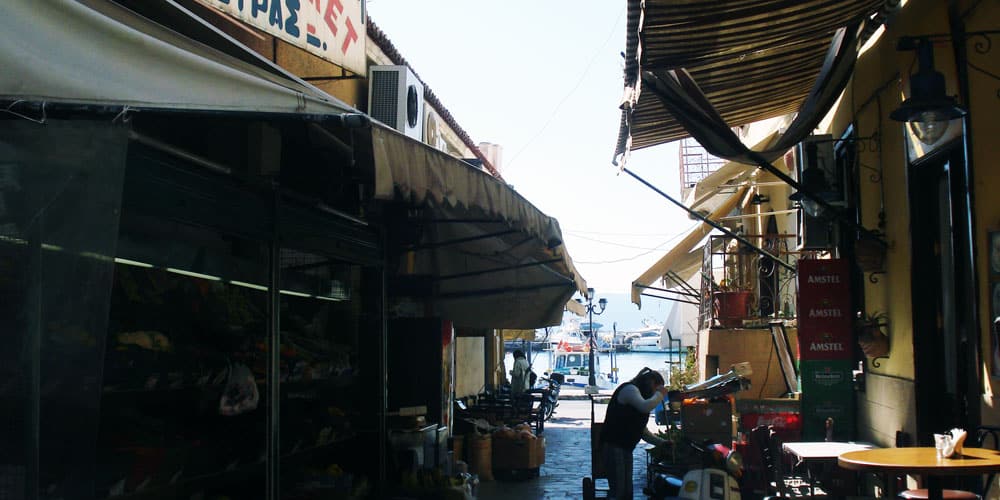
Enjoy fresh fish and traditional Aegina food and snacks in the fish taverns. Indulge in the pastry shops, in front of the harbor and in the beautiful alleys, where you can have your coffee or drink. In the captivating atmosphere of the night, have fun and dance in the music venues of the city.
The buildings in Aegina are examples of Neoclassical architecture with a strong folk element, built in the 19th century, they remain there as a reminder that Aegina was the capital of Greece for 2 years.
Many of these buildings house on their ground floor traditional coffee shops, patisseries, taverns, shops and bank branches.
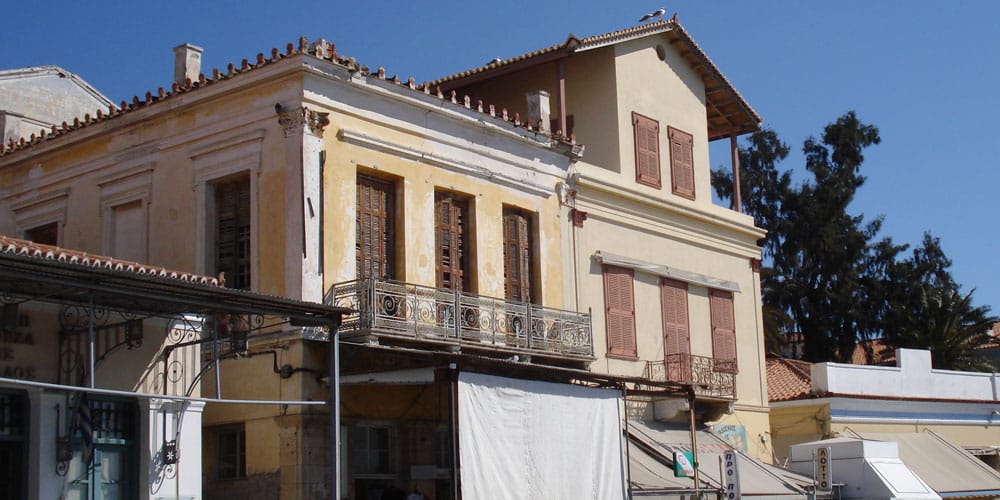
Inside, the colorful houses with small yards, with trees and flowers, some blue, green, red and white, are located in narrow alleys, between picturesque shops and taverns. The city of Aegina is beautiful, picturesque and strangely submits the visitor.
Aegina attracts a lot of people due to its proximity to Athens, with the result that in recent decades tourism has been the main economic activity of the locals.
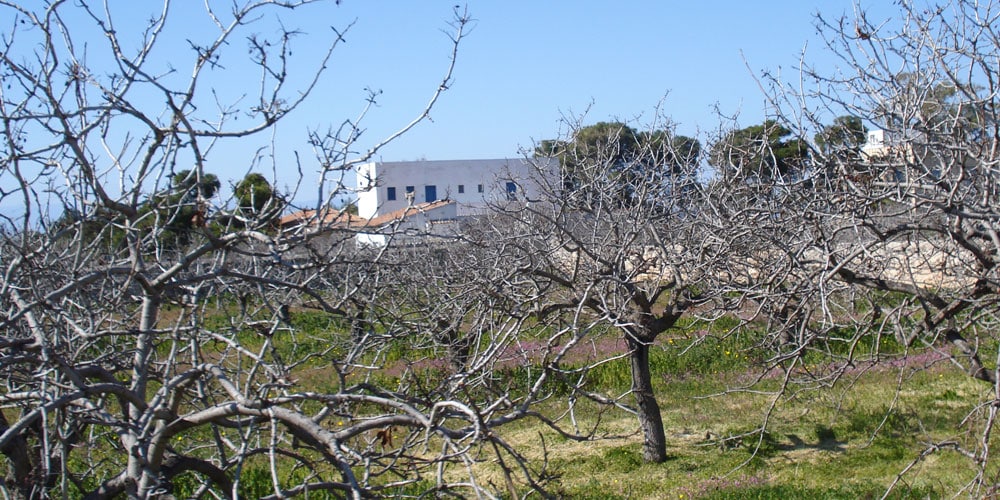
Religious tourism also plays an important role in the economy, which is increased due to Agios Nektarios, as well as archaeological tourism due to the temple of Afaia and the Byzantine monuments.
Its proximity to mainland Greece means this is one of the most visited of all the Greek islands – popular with day-trippers, Athenian weekenders and longer-stay package holidaymakers from northern Europe. Aegina Town, on the west coast, has some grand old buildings, an attractive working harbour and a very “Greek” feel to it.
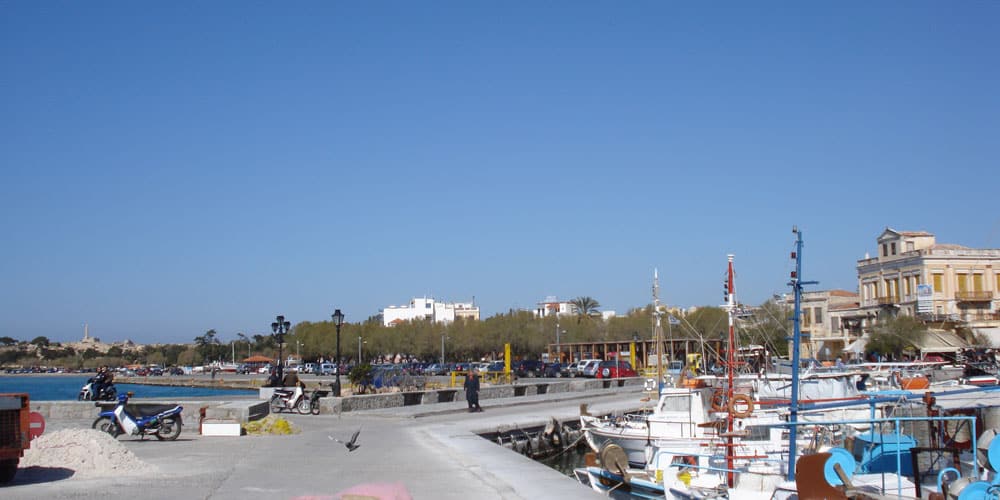
In fact so many Athenians now live here and commute to the capital each day that the place has almost become a suburb of Athens.
Aegina island is beautiful, picturesque and its beauty is undeniable. A typical sight in the city are the rickshaws, which non-stop cross the coastal road of the island.
The island has an ancient history and for this reason several attractions of archaeological and historical interest. The beautiful natural environment, its tourist development and the very close distance of the island from Athens, make it an ideal destination for short and long escapes from everyday life throughout the year.
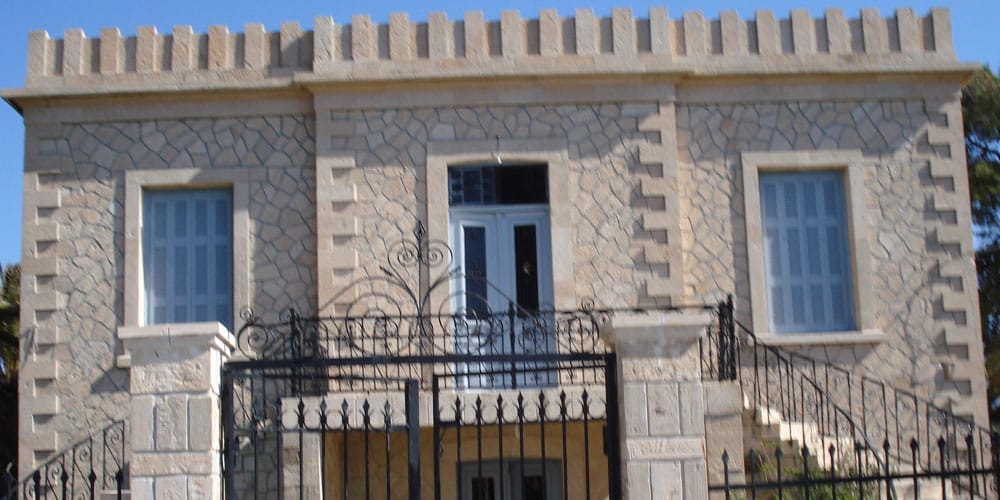
The buildings of the island are examples of Neoclassical architecture with a strong folk element, built in the 19th century, they remain there as a reminder that Aegina was the capital of Greece for 2 years.
Within the city of Aegina, but also inland, you will find many interesting sights, which are worth visiting.
In Aegina you will find cosmopolitan organized beaches, excellent local and international cuisine, pine forests that reach the sea and a wide variety of options when it comes to your nightlife.
History
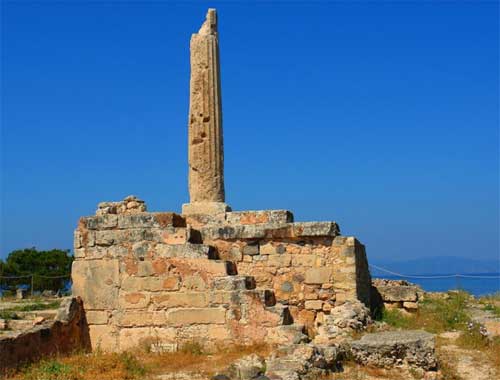
The island was inhabited during the Stone Age, and was to become an important place in antiquity.
An interesting fact about the island is that the first coins of the western world were made here in the 7th century BC.
When the Persian wars broke out in the 5th century BC, Aegina sided with them, probably because of its rivalry with Athens.
The island changed sides though, and after the battle of Salamis it allied with Sparta. War broke out with Athens, and most of the islanders sought refuge on the Peloponnese.
During the middle ages, the island was constantly raided by pirates, and the Venetian and Turkish invasions took their toll. The island was liberated in 1830, and Aegina’s town was the first capital of free Greece. The first modern drachma was also minted here picturing a Phoenix rising from the ashes. The island also had the first newspaper and prison.
Towns and villages
Aegina Town
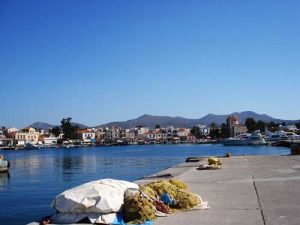
The waterfront is where everything gravitates, including most of the traffic. Dozens of bars and clubs emphasize that this is a party island, yet quiet corners ensure plenty of genuine Greek charm.
The island-grown pistachios are on sale everywhere, most notably at the growers’ cooperative by the harbour gates. Boats moored to the quay also sell fresh fruit, vegetables nuts and raisins. And among the usual tourist boutiques are craft shops specialising in the local hand-made pottery.
Tables line the main promenade at night while tasseled horses pull the tourist traps to and fro. The austere and much photographed chapel of Agios Nikolaos, sits alone at the water’s edge. Richly retired Greeks have thrown up no end of retirement homes that lend a flat, suburban air.
Nevertheless there is much to see. The Greek Orthodox cathedral of Agios Demetrios is where the first government of modern Greece was sworn in and north of the town at Cape Kolona is a fluted 23-ft column, the surviving remnant of a 5th century BC temple to Apollo. Recent excavations in have uncovered a theatre and a stadium. Nearby, a small, sandy beach called Avra, or Kolona, has sunbeds and tavernas.
Perdika
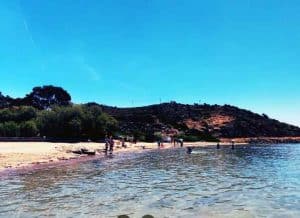
At the far end stretches Perdika, a picturesque port with white houses and garlands of octopus drying in the sun. A dozen traditional taverns and nonchalant bars stretch out in balconies above the colorful boats. Without hesitation, we sit down at the Saronis tavern, run by a professional fisherman from the island, and order katsoulès, the small pink fish from Aegina, tastier than red mullet.
Souvala
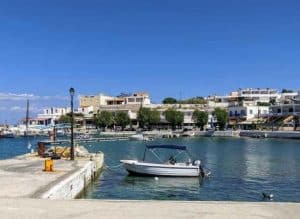
It is the 2nd port of the island. Of course, ships approach the port only during the summer months. Along the beach road, there are shops, restaurants and steakhouses. There is also an ATM machine.
There is a public transport connection, as Loutra Souvala beach is located there. In the past, they were hot thermal baths with a temperature of 25.4 degrees Celsius. Of course, over the years, their power weakened. Souvala is located near the area of Agioi and Vatheos. There is also transport coverage here
10 km from Aegina town there are the famous Spa of Souvala as well as nice beaches and many accommodations..
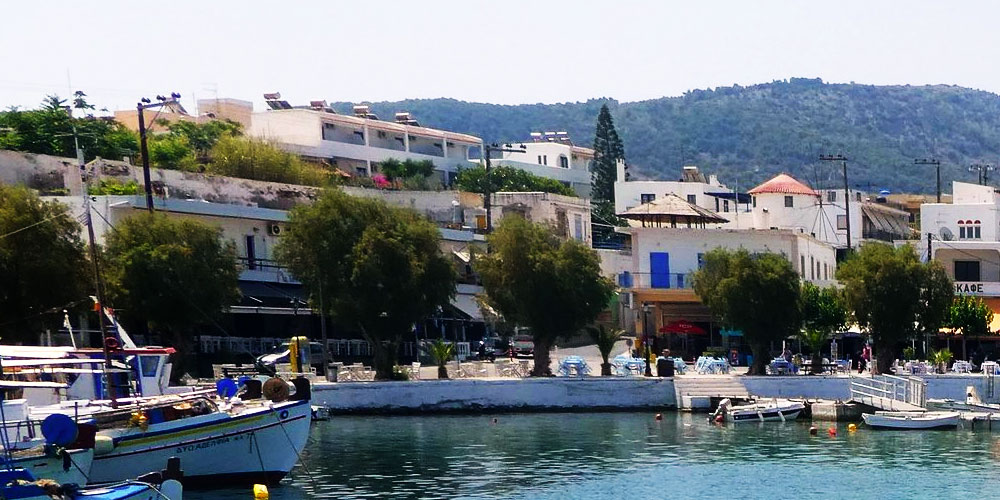
Marathonas
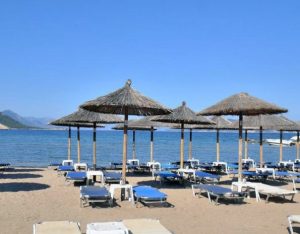
It has two sandy and shallow consecutive beaches with enough vegetation of eucalyptus, reeds and bushes, they are ideal for families. On the first sandy beach, there are many shops offering food, coffee or drinks, while the second sandy beach is also suitable for games and rackets, with umbrellas, sunbeds and a wooden canteen in the middle of the beach.
In addition, Marathonas has developed into a tourist resort and has many rooms for rent, small organized studios and apartments.
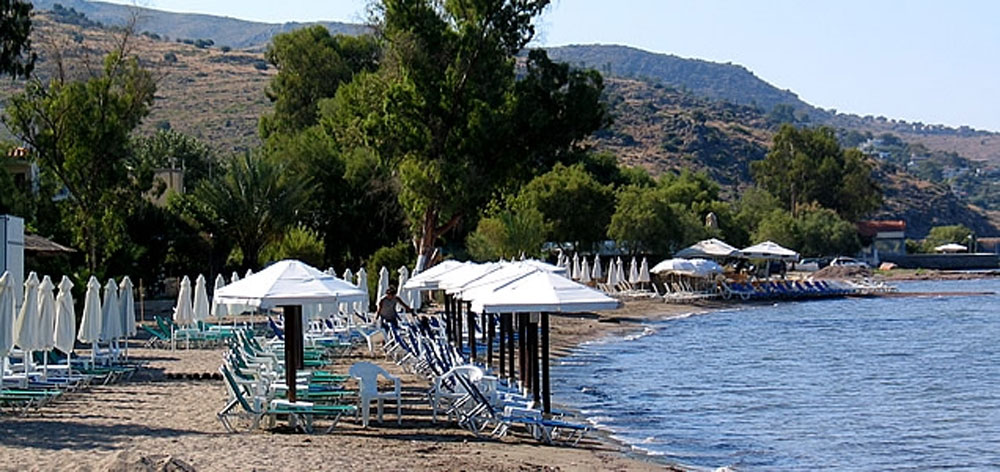
Agia Marina
Aegina’s most popular resort, Agia Marina is a favorite summer destination for Greeks and foreigners alike. It has the island’s largest sandy beach of 500 meters, very well organized, with water sports, shallow waters suitable for young and old, while it is surrounded by large and dense pine trees.
But apart from the main beach, there are many secluded coves where you can dive off the rocks and test your spearfishing skills.
There are plenty of options for food, since beach bars, taverns and ouzos stretch along the entire length of the beach road and beyond.
At the end of the beach, you can visit the homonymous church of Agia Marina, which every year on July 17 celebrates with a festival.
Agia Marina can be reached by local transport, but also by car heading east, 14 km from the port of Aegina, while there is also a direct route to its port from Piraeus.
In the resort village of Agia Marina you can visit the ancient temple of Aphaea near by there is a nice beach, Agia Marina is the only place of Aegina that attracts package tourism due to the vicinity of the Ancient temple and the developed tourist infrastructure.
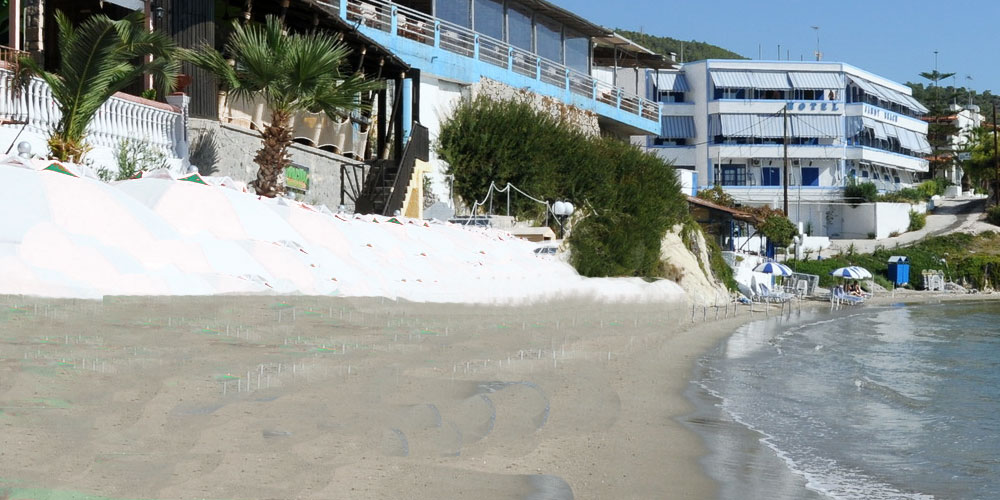
Pachia Rachi
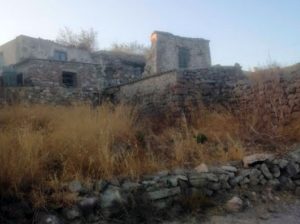
The settlement was characterized as Traditional in 1996 with stone houses, cobblestones paved with black stone and the old porcelain cisterns. At that same time, with the closing of the School and families with children moving down to the town of Aegina, the village lost its morning his prime.
Athenian and foreign visitors found ruins, bought them from their owners and built nice stone houses with large gardens, overlooking Mount Oros, the highest of the Saronic and respecting the physiognomy of the once-domesticated village.
The residents sit on the sidewalk of Agios Dionysios and talk, the children play carelessly in the streets, the new residents leave their cars outside the village. The current mayor of Aegina,said that he is against asphalt paving, the cobblestones are suitable for the narrow road” which is also the backbone of Pachia Rachi.
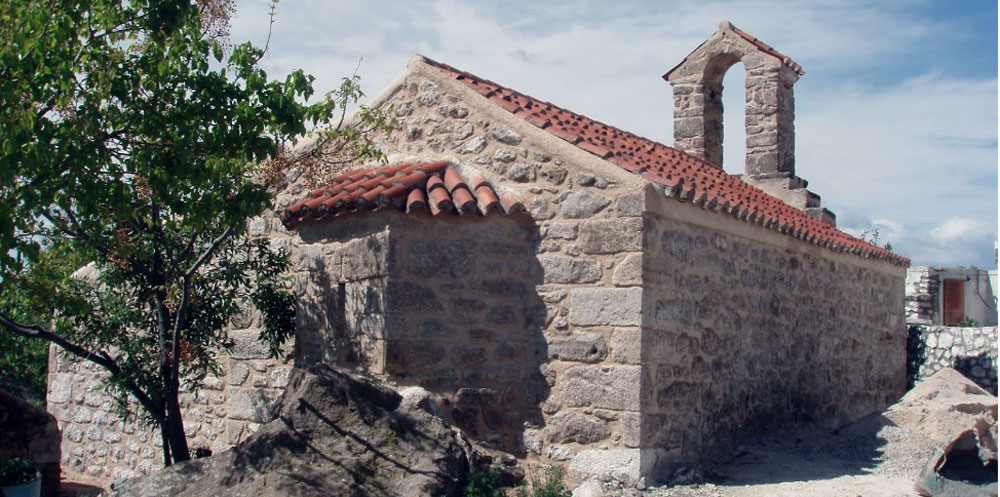
Paliachora
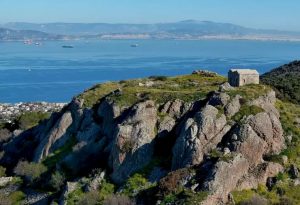
The settlement that was created remained invisible in a way, thanks to the technique and materials used in the construction of the houses. When the danger passed, the inhabitants began to leave the settlement of the hill of Paliachora and go down to the coastal areas.
Tradition wants the churches of Paliachora to be 365, as many days as there are in the year. Historical studies, however, state that there were actually around 50. Today there are about 33 churches left.
Several of these have been restored (Agios Georgios the Catholic, Agios Dionysios or Episkopi, Agios Eleftherios, Agios Minas, Agia Marina,. Don’t forget to climb to the top of the hill where traces of the Castle of Paliachora (built by the Venetians in 1654) are preserved to enjoy the view to the other side of the island, but also to visit the Monastery of Agios Nektarios, the patron saint of the island, located at the foot of the hill.
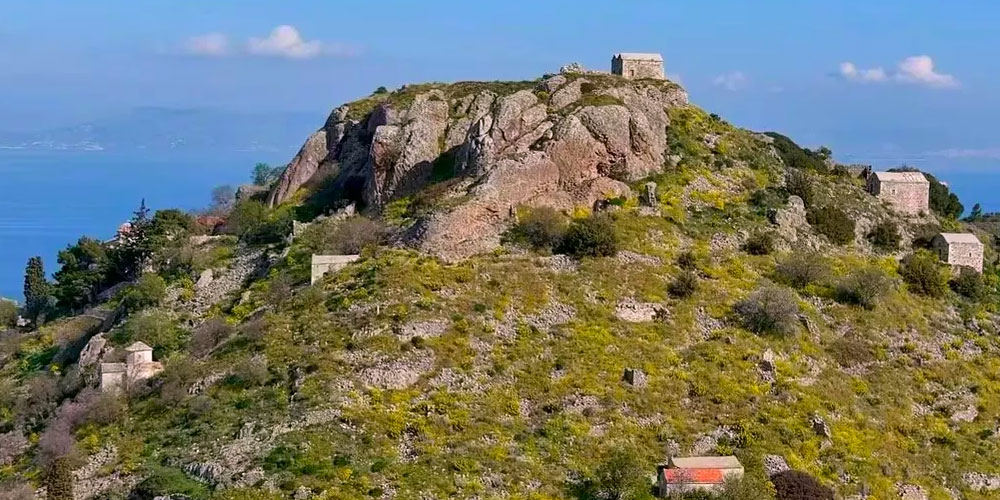
Mesagros
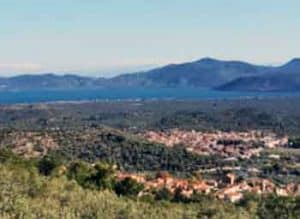
It is located in the continuation of the route, from the main axis of the road to the Monastery of Agios Nektarios. A route that leads both to the area of Agia Marina, but also to the temple of Afaia.
Mesagros is well-known and especially known for the potter craftsmen who lived in the area. The soil from the surrounding mountains was what helped the development of pottery since ancient times. Mesagritic jugs are still known for their quality and the preservation of water at low temperatures even in the summer months, without any technological support.
An important fact is that its climate was one of the driest in Greece. There is a connection with transport as it is located in a central point.
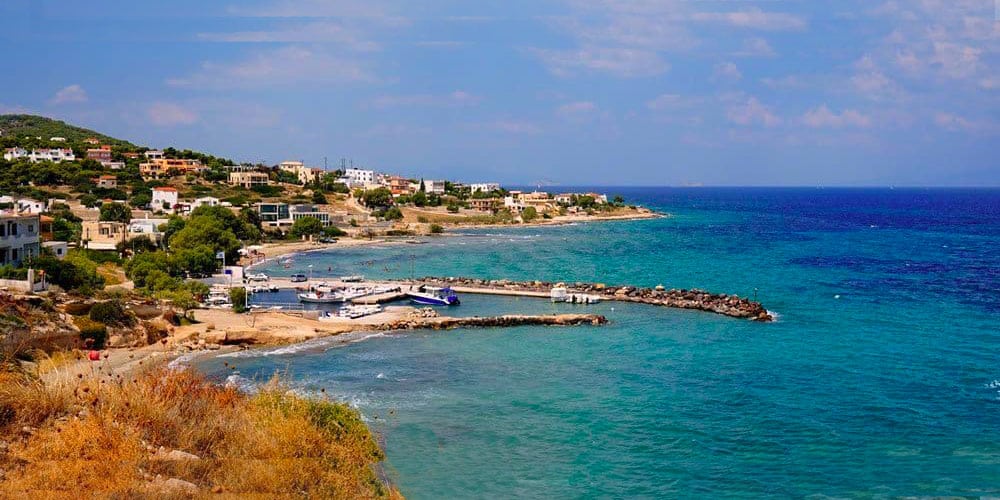
Portes
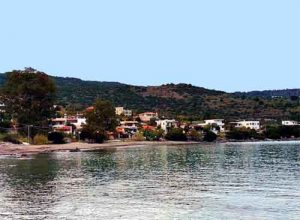
In the area there is a beautiful, rocky and a little secluded beach with pebbles, several pine trees on one side and a sandy beach on the other with a small picturesque harbor for the boats of the area.
These specific beaches offer the peace and quiet you are looking for, away from the crowds and noise.
As for its name, it is said that “Portes” comes from porto as it was called in the past, as its position facilitated trade and from there cargoes of raisins, figs and retsina left for various destinations.
Another version of the origin of the village’s name states that in order to protect the inhabitants from pirate raids, they only had doors and never windows in their houses.You will reach Portes by following the coastal road from Agia Marina, after a beautiful green route or by going down from the mountain village of Anitsao.
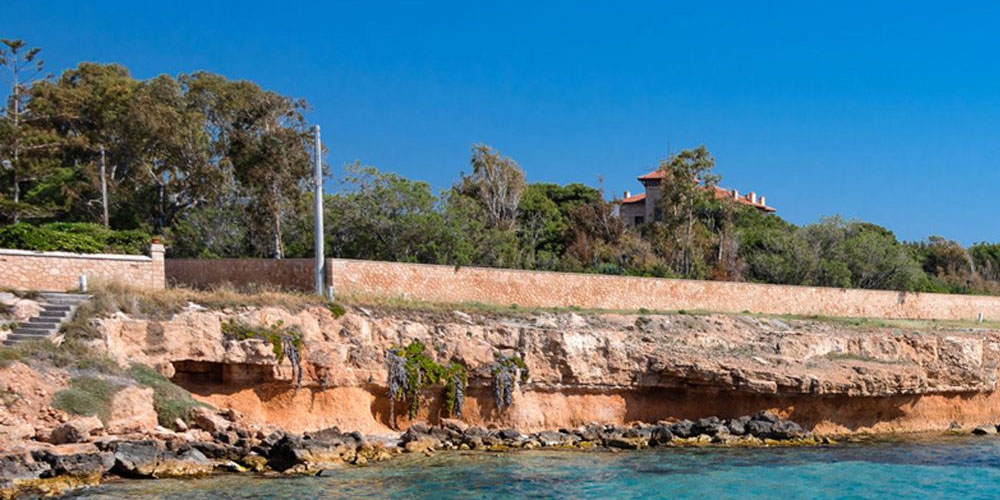
Vagia village
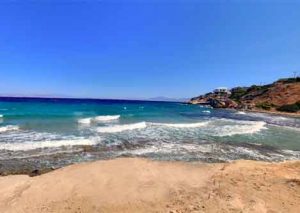
You will reach Vagia if you follow the coastal road from Souvala, and 4 km after that you will come across a small picturesque tourist resort.
Vaia has one of the most beautiful sandy beaches of the island, while for the more alternative, within a breath’s distance is the wonderful bay of Tourlos, a point where it was chosen by the Germans as the most strategic point in the area during the Second World War.
It has few taverns with very tasty food, while if you feel like going out at night, the town of Aegina, Souvala and Agia Marina are only a few kilometres away.
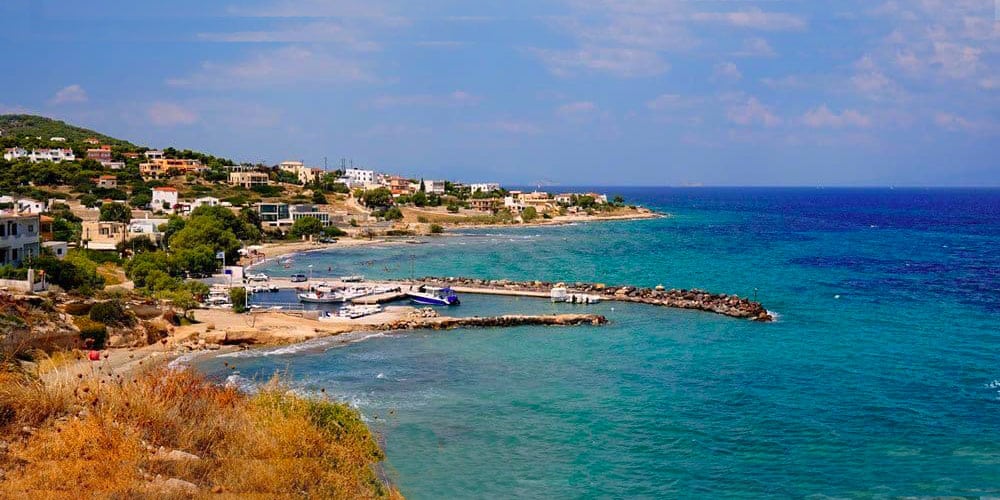
Aeginitissa
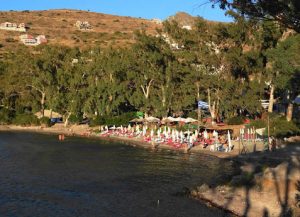
Cosmopolitan, organized, with good food, nice music, fenced racket court, ideal for young people and families.
The area harmoniously combines tranquility with possibilities for entertainment and is a great choice to visit, and it is worth staying until sunset as the sunset is magnificent.
Aeginitissa was formerly the property of the Monastery of Panagia Chrysoleontissa. The lush vegetation reaches all the way to the sandy beach and the greenish-blue clear waters are impressive.
Access to the beach is very easy by road through the road network that connects the port with Perdika or alternatively you can also take the KTEL bus.
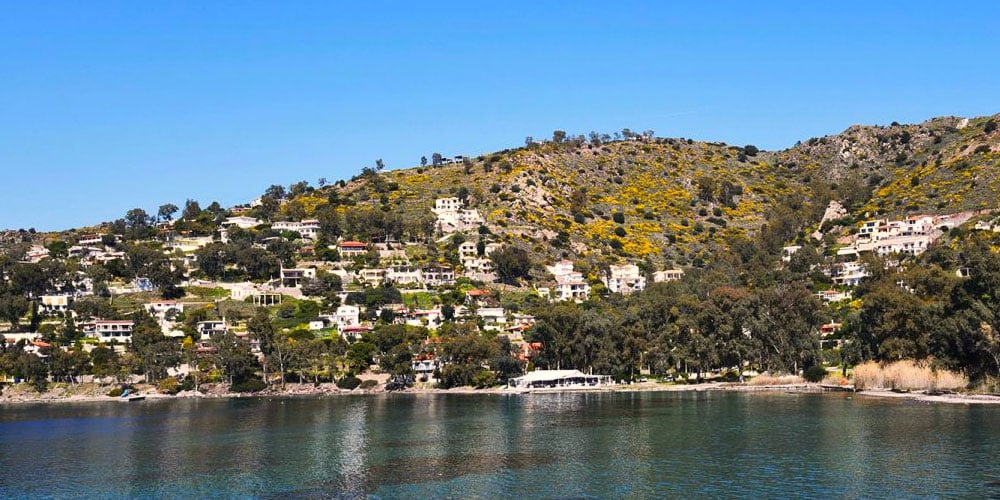
Kypseli village
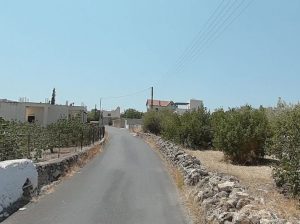
Kypseli used to be called “Halasmeni (damaged” because of a half-destroyed church that was located near the place where the present church is. This is one version. The second is related to some more general disaster that may have occurred in the place. Tradition also says that Kypseli used to be called Marnas or Mesonisi (together with Moulos and Kavouropetra they are current toponyms). Whatever it is, it got its current name in 1949.
The church of Kypseli is built in its central square and celebrates March 25, the Annunciation. Directly opposite is the building of the Spiritual Center of Kypseli. In Kypseli, with its fertile soil, there are some of the largest estates with pistachio trees and their cultivation, along with agriculture and fishing, was for years the main occupation of its inhabitants.
But even today the agricultural products from Kypseli producers always remain excellent. In Kypseli there were some of the most famous taverns of the island, but even now many people visit the taverns of the area for really good food!
Finally, we should mention that Kypseli had a great tradition in shipping and especially in sponge fishing, since it had some of the most famous sponge divers of Aegina.
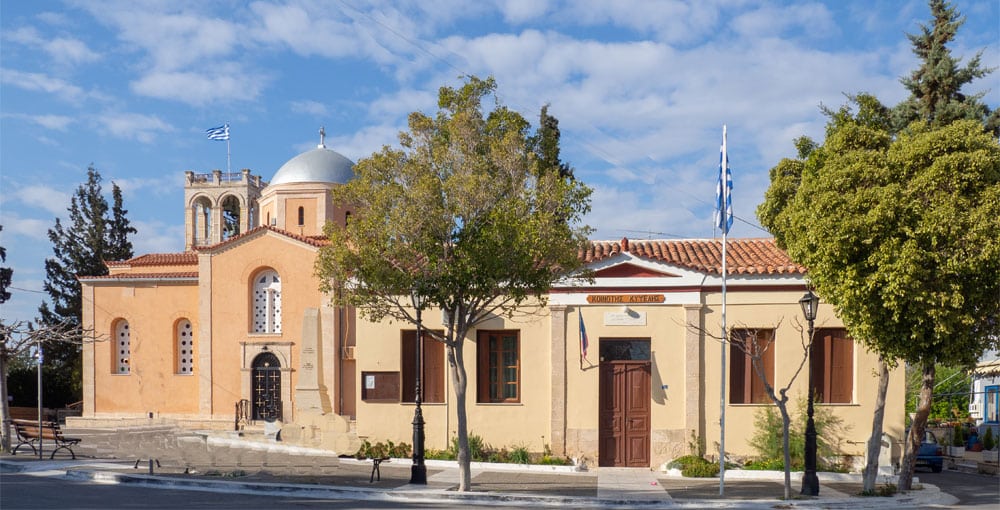
Where is Aegina
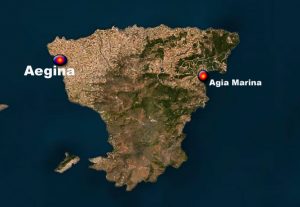
The northern and western areas consist of stony but very fertile plains, most of which is well cultivated to produce good crops of grain, vines, almonds, olives and figs and the island’s most notable crop – pistachio nuts. On the island there are many villages scatered along its fertile valleys.
The southern part of the island is volcanic with a rugged and mountainous terrain. The landscape is rocky and largely barren, and with a high point at the extinct volcano of Mount Oros (531 metres). A ridge extends northwards from Mount Ornos with narrow fertile valleys on either side, many planted as vineyards.
What to see
The island’s star attraction is the 5th century BC Temple of Aphaia and if this is your main purpose of visiting Aegina your best bet is to arrive by boat at Agia Marina. From here you can walk to the temple which is perched on a pine-clad hilltop overlooking the busy resort. The impressive temple pre-dates the Parthenon but is one of the best-preserved ancient temples in the whole of Greece.
From Piraeus, it only takes an hour by boat to reach Aegina, an island that has remained very authentic. The ferry lands directly in the heart of its lively city. To the right stretches its port with its fishing caiques and its magnificent row of neoclassical houses, at the foot of which are cafes and taverns. On the left, the archaeological site of the ancient city of Aegina juts out into the sea.
The port invites you to stroll along its quays and get lost in its streets dotted with small shops, the fish market being the nerve center. On either side, you can regain your strength facing the sea on the terraces of traditional cafes and restaurants.
At the entrance to the port, the walk in the ancient city of Aegina is not to be missed for its remains and the view it offers on the sea. The site, called Kolona, is topped by the temple of Apollo to the only standing column.
At the gates of the city, the archaeological site of Kolona is the subject of a pleasant walk to the temple of Apollo which crowns it. Covered by the remains of the ancient city, the promontory offers a panoramic view of the port and the bay just behind.
The Olive grove of Aegina
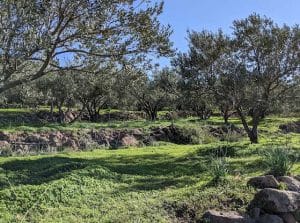
There, the visitor can meet centuries-old olive trees, impressive in size and formation, whose age reaches or exceeds 2,500 years, according to scientific conferences that have been presented in Aegina in recent years. It is a historical monument, the preservation of which has been helped by the fact that no road has been built.
Access to Eleonas requires quite a bit of walking, from a difficult path whose entrance is located near the second beach of Marathon. However, even this difficult hiking route, for those untrained in walking, will compensate with the wild beauty of the landscape and rock formations, the formation of the land. A configuration that one would rarely think can be found in Aegina. The Olive Tree of Aegina is a UNESCO protected monument. In the area one can find chapels of great beauty, such as those of Agia Kyriaki, Agios Georgios and Agia Triada.
Ellanion Mountain
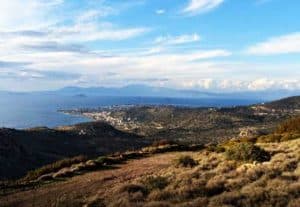
On Hellenic Mountain, in Aegina, the oldest altar that has been identified to date was built, which was dedicated to Zeus. Although its construction coincides with the descent of the Dorians in 1200 BC, in the same place there was an older settlement, which according to the archaeologist Welter, was abandoned in 1250 BC. after a raid that took place in the area. The study and excavations of the site brought to the surface jewelry, metal objects, but also food items such as jars of wheat. Everything indicates that for some reason this area was abandoned in a hurry. Perhaps after some raid or kidnapping of its inhabitants.
Despite the steepness of the barren terrain of the Hellenic Mountains, there were fortified structures that apparently protected their inhabitants from raids. A second version states that perhaps its inhabitants did not have friendly relations with the local population. Perhaps it was a war party that settled there and used the location as a base for marauding raids.
What is certain is that the inhabitants of Mount Hellani were Greeks. The construction of the altar in honor of Zeus testifies to this. A location on the western side, at the foot of the Mount called “Sfyriktres” also gives great value to the area. Some works had been built there which helped the pilgrims of the altar to climb the difficult paths of the mountain.
These were flattened steps, a guest house and two tanks that collected rainwater. In one of them in 1906 a bronze hydria was found which was dedicated to the Hellenic Zeus. It is also possible that there was a temple dedicated to Hekate at this particular location. In this area, during the Byzantine period, a monastery was built which was dedicated to Agios Nikolaos. Of all its buildings, only the church of Taxiarches is preserved. It dates from 1200 AD. and is one of the oldest churches of Aegina.
Hellenic Center for the Care of Wild Animals
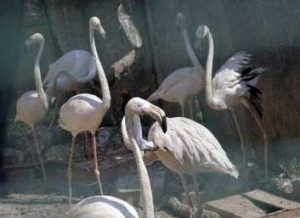
Treatment of those wild animals that are injured and unable to survive and reintegration into the natural environment of those of them after treatment that are healthy and able to cope on their own.
Gathering data on the dangers that threaten wild animals throughout the territory.
Active action to minimize the risks that threaten wild animals by developing preventive action and proposals to agencies.
Protection of endangered species through raising awareness and informing the public and competent bodies, implementing the state policy
Church of Agios Nektarios
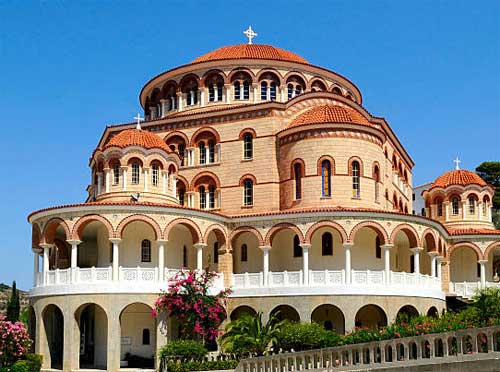
A former dean of the School of Theology in Athens, St Nectarios was renowned for his healing powers and was the first saint to be canonised by the Orthodox Church in modern times.
He is buried here and is the patron saint of those with cancer, heart trouble, arthritis, epilepsy – even the unemployed.
Agios Nektarios lived from 1846 until 1920. The church – said to be the largest in Greece – is south of Souvala on the main road from Aegina Town to Aghia Marina and there are plenty of buses.
There is a mass pilgrimage each November which Patricia Storace describes in her book Dinner with Persephone. There is a good taverna opposite when you get tired of trudging around.
Temple of Aphaia
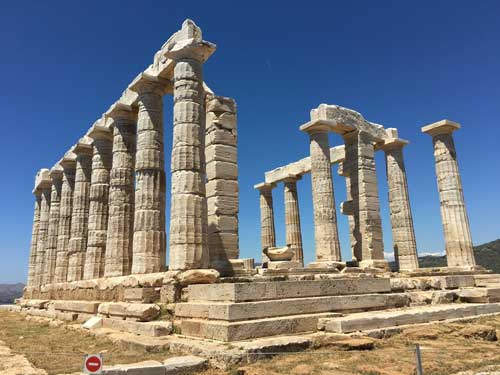
It was dedicated to Aphaia – a hunting nymph daughter of Zeus and very much a local divinity – and first excavated in 1811 and again in 1901 when it was stripped of its most important artifacts which now grace the rooms of German museums. Some of the less important finds can be found in the museum in Aegina.
Archaeological work was resumed in 1966 and has continued on and off for 20 odd years. The temple is approached by a ramp from the east near former sacrificial altars. South of the temple are traces of an entrance gate and the priest’s lodgings.
A regular bus service goes past the temple from both Aegina Town and Aghia Marina. You have to pay to go in. It’s been repeatedly struck by lightning so now there’s a thundering great metal rod at one end. The views from here are staggering, at least where pine trees don’t stand in the way.
The Temple of Aphaia formed a sacred triangle with the Parthenon on the Acropolis and the Temple of Poseidon at Cape Sounion. The site is strikingly beautiful. Surrounded by a pine forest and overlooking the Saronic Gulf, this Doric temple in a remarkable state of preservation stands on a promontory facing the sea and Athens in the distance. It was built around 480 BC. Together with the Parthenon on the Acropolis and the Temple of Poseidon at Cape Sounion, it formed a sacred triangle in antiquity.
The Aeginetans adored Aphaia, a Cretan nymph associated with Artemis, the goddess of hunting and wild nature. Representing the fight between the Lapiths and the Centaurs, copies of the pediments are exhibited in the small site museum
See the ruins at Paleochora

The former town is set in the side of a steep hill, crowned with the ruins of a Venetian castle. In the 18th century there were around 400 homes here and 20 or so churches.
The town was abandoned in 1826 and most of the houses demolished but a cathedral and some chapels have been restored and many contain excellent frescoes and impressive iconostases though you need permission to view.
Get there early and there is usually someone around to unlock doors and point out the most interesting sights – remember to offer a good tip for the trouble.
Paleochora is an abandoned Byzantine town which can be visited as well. In Aegina also is the house where Nikos Kazantzakis the editor of Zorba the Greek lived for some years. Worth seeing is the mansion that hosted the first government of Greece under the leadership of Ioannis Kapodistrias.
Thanks to the development of its ancient paths by local associations, Aegina is a paradise for walking. One of the most striking rides winds around the rocky hillock of Paliachora, the ancient capital of the island. For 1000 years, when the Aegean Sea was infested with pirates, the inhabitants had retreated to this promontory, before abandoning it in the 19th century to return to port.
Remains of the city about thirty moving chapels which dot the hill, as well as the ruins of a Venetian fortified castle at the top. When they are open, the chapels touch with their faded frescoes and their small icons.
The islet of Moni
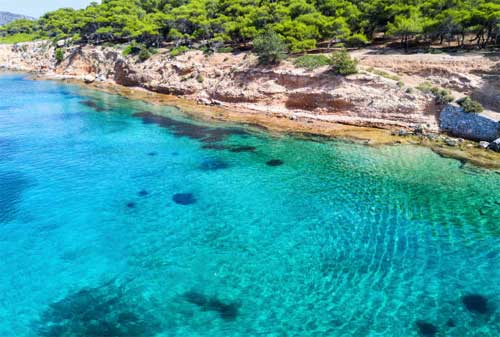
Someone once tried to build a hotel there and the remains are still evident.
Moni was once owned by the Monastery of Chrysoleontissa – hence the name – but is now apparently the property of the Touring Club of Greece which levies a small charge for visitors and runs a campsite on the northern slopes.
Thickly wooded on its western side, Moni has become something of a nature reserve with deer, rabbits, wild goats – and peacocks that squabble for scraps from day trippers.
There is a path to the summit and the reward is the view of a German bunker left over from the war. The Moni islet has a small sand and stone beach with shallow waters but the rocky shoreline is probably more suitable for those who enjoy snorkelling.
What to do
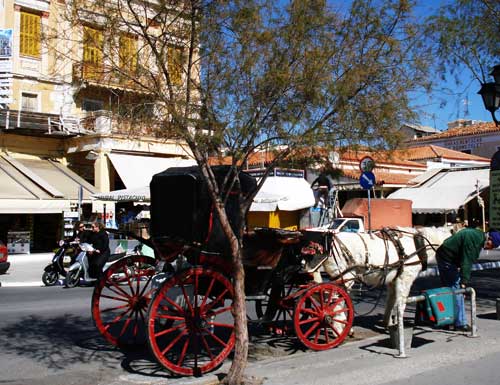
The island of Agistri is the nearest to Aegina. The beautiful resort of Peloponnese Methana is only 20 minutes away by boat and further on is the green island of Poros, all ideal for daily excursions.
The island’s interior is a paradise for hikers with its wooded valleys, olive groves and pistachio orchards nestling amid low mountains. Pistachios are Aegina’s biggest export so don’t forget to buy some to take home because they’re supposed to be the best in Greece.
Foodies will find some wonderful waterside tavernas cooking up the freshest imaginable fish dishes and mouth-watering mezedes served with a metal jug of the local retsina.
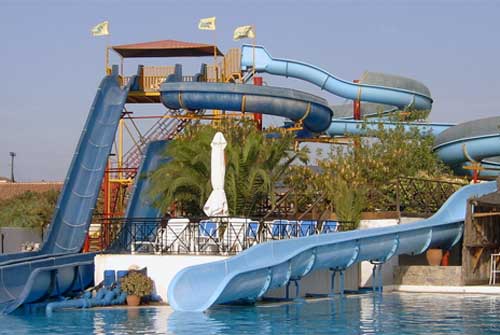
The villages and surroundings on Aegina are lovely, so it is well worth it to explore the island. Because of its important position in antiquity there are still many ancient sites to see, the most famous being the temple of Athena Aphaia from the 6th century BC.
You can also visit the ancient sites on Mt. Oros, where the ruins of a temple to Zeus stand amongst others. Aegina’s town is very nice to walk around in, and here there is a very interesting archaeological museum. The monastery of Ag. Nektarios is a very interesting place to visit. The saint himself is buried here, and is said to hold miraculous, healing powers. The island has a very lively nightlife especial on weekends.
Among things to do in Aegina that will charm the visitor, are its archaeological sights, monuments, churches and museums. The town its self has many interesting buildings and neoclassical houses, among them is the first Greek government building, the Orphanage building that was founded by the first governor of Greece Ioannis Kapodistrias, the houses of the Greek revolution leaders Kanaris and Kountouriotis and the houses of the Greek politicians Spyridon Trikoupis and Harilaos Trikoupis.
On the dock you can visit the small white church of Agios Nikolaos and near by the church of Agios Dionysios the cathedral of Aegina. On the north peak of the town following the road from the port are the ruins of the ancient temple of Apollo.
Beaches
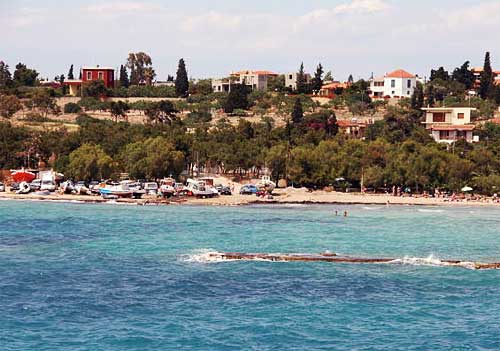
Most visitors head for the north coast beach resort of Agia Marina or to the east coast beaches.
Sandy beaches are in short supply and the island has more to offer in the way of interesting sights and good walks.
The beaches on Aegina are very nice. Agia Marina is probably the most popular one, since it is long and sandy. It is also suitable for children.
Other beaches you can find on Marathonas ,Suvala, Vagia and Perdika. In Kypseli you can swim at the beaches of Kavouropetra and Leonti. But also in the town of Aegina there are some quite nice beaches. One towards the temple of Apollo and the others towards the other side of the town.
Shopping
Aegina is best known for its ceramics, but you can also find many shops with jewellery, clothes and textiles. Try to get some local pistachio nuts with you.
Aegina use to be a commercial passage between the islands of the Saronic gulf and Piraeus. In the promenade of the town many commercial boats (Kaiques) used to dock sailing fruits and several products. Even today you can see some of them among the fishing boats along the dock.
Eating out in Aegina
There are both international and Greek restaurants in Aegina town. In the little fishing villages you can also have really nice meal, and the seafood is excellent. Tips: Just behind the fish market of Aegina town located some very nice and cheap restaurants, at the Restaurant Agora you can enjoy fresh fish especially Gavros and Cod fish (Bakaliarakia) , the small fried fresh shrimps are excellent mezes for ouzo or retsina.
To savor fresh fish, you will feast on salads, small fries and grilled meats at the popular Agora tavern, unless you prefer the more sophisticated and refined Greek cuisine of the Skotadis tavern, reputed to be the best on the island. To be tasted in particular: the anchovies marinated and flavored with lemon zest and the house salad accompanied by fresh cheese .
Nightlife and entertainment
Aegina promises an intense nightlife with bars that play both Greek and foreign music, satisfying all tastes! One of Aegina’s hot spot is the club Elliniko Seaside, which, among other things, has a floor with live Greek music.
If you want to drink your coffee in Souvala, then stop by the relatively new shop Anasa, which even has a floor for wild clubbing. In Agia Marina, on the other hand, you can’t miss the Lighthouse, where you can sit next to the waves of the sea and soak up the sun.
It would not be an exaggeration to say that the bar ‘Inn on the beach’ is right on the beach, which makes it a special hangout in itself. Also Belle Epoque and En Aegina, in the latter you can even enjoy live music in the basement, while if you like mainstream and pop sounds, then the upstairs is what you are looking for!
Accordingly, the cafe Liotrivi in Perdika is next to the beach and is open from morning until late at night offering coffee, drinks and snacks. But in Perdika there is also the bar Music, a place where you can drink your coffee on the white balcony overlooking the sea, while in the evening it offers perfect cocktails.
A good choice to enjoy your drink on the beach is Aqua Loca, a beach bar in Marathon, but also Barracuda in Agia Marina.
Finally, we suggest you stop by for a drink from the bar Island on the beach of Aegina, in Remvi, but also in Mask which is located a short distance from the Metropolis.
Where to stay in Aegina
Staying in Aegina town is the best option, you will have the convenience of arriving by ship directly near where you will stay, plus, you’ll already be where most of the nightlife takes place with many restaurants, cafes, shops and near by beaches that are totally within walking distance from your hotel.
Using the town of Aegina as a base for your holidays on the island is perfect, especially if you like the evening atmosphere with people strolling through the alleys. Along the west coast of Aegina there are many hotels all the way to Marathonas, Perdika and Souvala.
Agia Marina is another option for accommodation. The seaside resort at the east of the island facing Attica, is another good place to stay. It has sandy beaches and restaurants by the sea and the distance to the town is about 30 minutes drive.In any case, if you decide to sleep in Agia Marina, know that you will still need a vehicle because the buses are not exactly frequent.
When to go to Aegina
Aegina is a lively island all year round. Autumn is particularly pleasant there, with mild temperatures (12-22°C) and still warm seas (18-20°C), as is spring. The island remains lively in all seasons.
Located in the sheltered Argo Saronic gulf, Aegina enjoys the much the same climate as Athens. Summers are hot, sunny and virtually cloudless from June to August. Spring and autumn are cooler and showers that fall in April and October are far less frequent in May and September. June sees temperatures rise from 21 to 25°C and they often hit 30°C in August. Winters on Aegina are relatively dry with most rain in November. Winters are mild at an average 8°C.
Getting around Aegina
Aegina has a good road network in the north of the island, less so in the south which is more mountainous and with fewer resorts. Aegina town has several car and bike rental offices directly opposite the port and more are based in Agia Marina.
Aegina buses and bus services
Aegina island has good bus services run by the Aegina Bus Company. The main bus terminus is located in Aegina Town in the square near the harbour.
Services in the north are Aegina Town – Kipseli – Vathi – Souvala – Nagia; to the south: Aegina Town – Marathonas – Perdika; and east are Aegina Town – Agios Nektarios – Agia Marina. Aegina bus timetables are available here.
Taxis and car hire
Most taxis gather at the harbour in Aegina Town to meet the ferries as they come in. You can also dial for a taxi – Aegina – 022635; Agia Marina – 032107; Kipseli – 0328873; Megasos – 071313; Souvala – 343606.
Hiking and walking trails
This is a good island for walkers with a trails right across the island, some taking in the most interesting sights – notably the trail from Agia Marina to Souvala via Paleahora and a circular walk from Agia Marina to Aphaia, Mesagros, Agios Ioannis and back to Agia Marina. Many walks are detailed in ‘A Walking Guide to Aegina’ by Gerald Thompson available at island bookshops. There is also a good Road Editions map for those who want to trek further afield.
Getting there
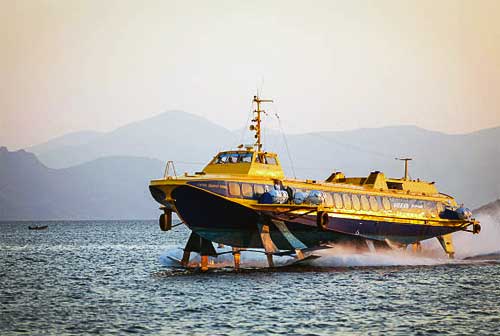
Athens Airport, is about 27 kilometres east of Athens. There is parking for 4,800 cars and the E96 shuttle bus service runs 24 hours to the ferry port at Piraeus. The bus stop is outside the arrivals hall and you must buy a ticket before boarding.
The E96 operates every 15 to 20 minutes during the day and every 30 minutes through the night. It stops several times on the way so it’s not ultra-fast with a journey time of 45 to 60 minutes depending on traffic.
The taxi rank is next to Door 3 of the arrivals hall and there are always plenty of taxis. Journey times depend on traffic and can be 30 to 50 minutes.
By ferry
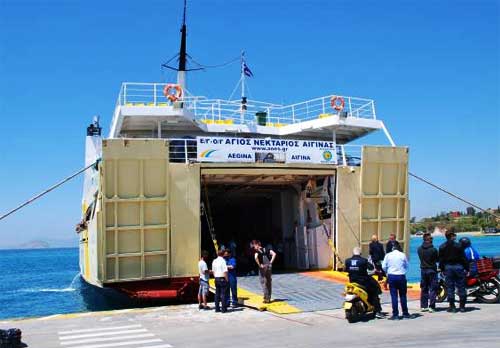
The main ferry companies are Hellenic Seaways (nine ferries daily from 7.30am; Nova (8am and 2pm); Agios Nektarios (10am, 2pm, 4pm) and the Aegean Flying Dolphins (hourly from 6am).
Anes Ferries operates a daily round-trip ferry from Piraues to Aegina.
There are ferry links to the three main ports on Aegina – Souvala, Agia Marina and Aegina Town with connections from Aegina port to the other Saronic islands of Angistri, Hydra, Poros and Spetses with further ferry links to the Peloponnese (Epidaurus, Hermioni, Porto Cheli, Tolo, Isthmia, Nafplion) and Attica. Some of the connections are seasonal.
Spetses, Hydra, Poros, and Methana have year-round ferry links but Piraeus can be a better bet for other islands out of season.
A comprehensive list of daily sailings is posted outside their Port Authority office on the harbour and officials, not unreasonably, get a little tetchy with tourists who press for information.
Facts about Aegina
Population: about 10 000
International code: 0030
Airport:: No
Local code: 22970
Cashmachine: Yes
Health Center: 22222
Internet cafe: Yes
Police: 27777
Highest Mountain: Mt Oros 532m
Port Police: 22328
Price rate: Average
Tourist Information: 4199200
Tourist police: 22391
Hotel Association: 22424
